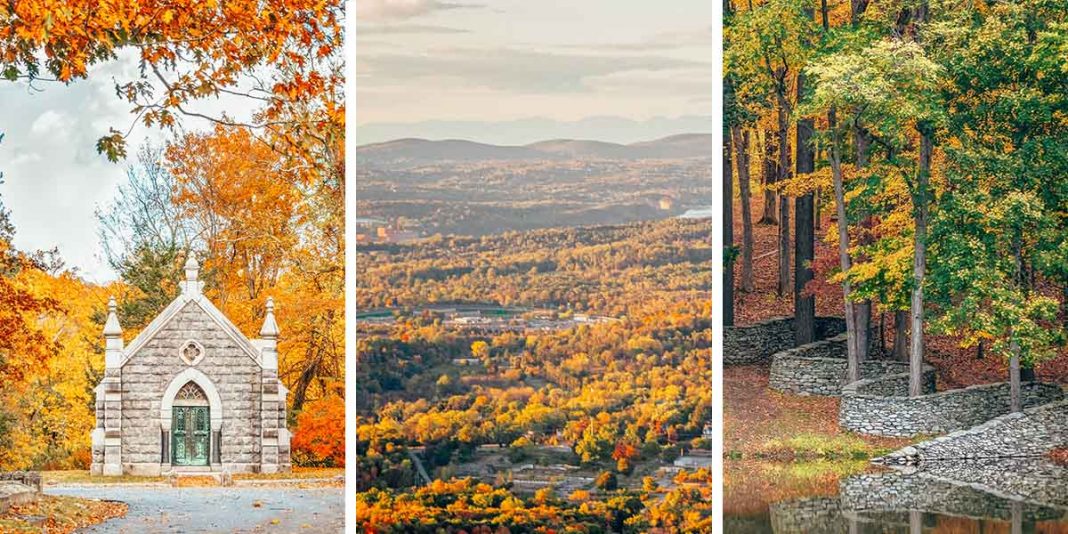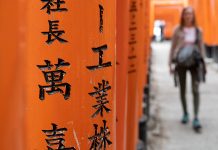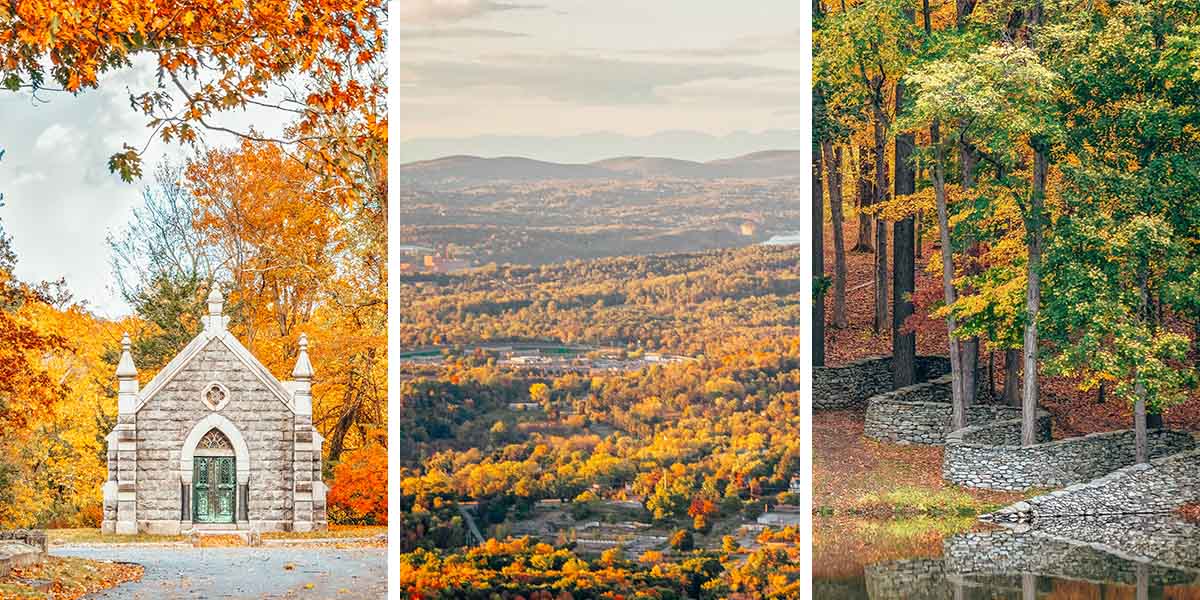
Apple picking. Mountain hikes. Mansions and crumbling castles. A headless horseman?? The Hudson Valley, a region just north of New York City, is full of fascinating history, beautiful scenery, and more than a few surprises. In autumn, the area comes alive with some of New England’s best fall foliage displays, farm-to-table food, and the spooky attractions of Sleepy Hollow. Less than an hour away from NYC, Hudson Valley is the perfect weekend getaway!
With so many things to do and see in Hudson Valley, it’s hard to know where to begin. Luckily, we tapped a local who grew up in Hudson Valley, Leah Wersebe, to give us all the details! Take it away, Leah.
Psst: Planning an East Coast adventure? We have a few other posts exploring the East Coast!
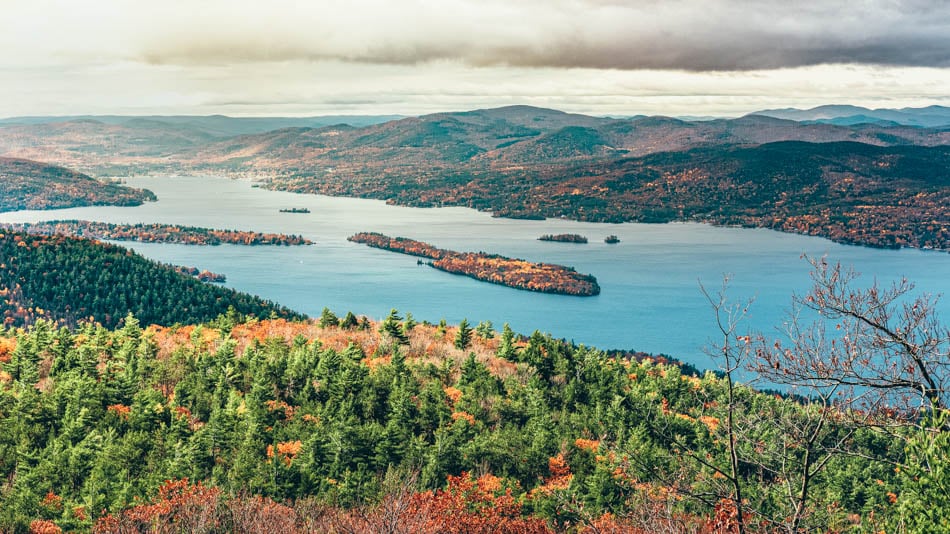
Where is Hudson Valley?
I grew up in a town in the Hudson Valley, and after almost a decade of living in New York City, I moved back to my hometown. It’s a lot different than I remember, but there is also a chance I wasn’t paying close attention. Moving back as an adult, I discovered a booming microbrewery and cider house industry, a growing cultural scene, and dozens of hikes that apparently everybody knew about but 17-year-old me. Teenagers – what can I say?
The Hudson Valley, which is different from the geographical Hudson River Valley, encompasses the area surrounding the Hudson River from New York’s capital Albany to the northern Bronx in New York City. The areas just outside of NYC and Albany include some typical suburban spaces, and scattered throughout the region there are a few small cities, like Poughkeepsie, Middletown, and White Plains.
Most of the region is a hybrid of suburban and rural land and includes farms, quaint towns and villages, and preserved wilderness. The Appalachian Mountains run through the Hudson Valley, so there are a few hikes in the area, like Anthony’s Nose mentioned below, that connect to the Appalachian Trail.
There is a lot of economic and cultural growth happening as more middle- and upper-middle-class people work remotely and/or have flexible schedules and don’t need to live in NYC… plus nobody wants to live in Long Island anymore. (Don’t come for me about this unless you’re from Long Island. If you’re from Long Island, we can have a civilized debate about the best place to live in NY like proper New Yorkers.)

How to get to Hudson Valley?
The most popular public transportation route is via Metro North trains from Grand Central Station. Use the Metro-North website for times, and just make sure you catch the last train of the evening back to the city as the trains stop running after a certain point until about 4am the next morning.
Another train option is the Amtrak train, but the only station in the Hudson Valley is Poughkeepsie (a small city about halfway between Albany and NYC).
If you plan on staying for longer than a day or your primary goal is to get outside of the towns, go for a hike, or visit an apple orchard, consider renting a car. Renting a car will give you the flexibility you need and allow you to go to places like state parks and other attractions off the train lines.
You don’t have to rent a car in NYC if that makes you a bit nervous. You can take a Metro-North train out of the city and rent a car in Croton-Harmon, Tarrytown, or Poughkeepsie — plus, it’s often cheaper than renting a car in the city.

What’s the best time to visit Hudson Valley?
The best time to visit the Hudson Valley is the fall. It has that hardcore autumnal leaf situation going on everywhere, the views on your hikes look like a million bucks, and there is so much to do that you will never be bored.
However, if you aren’t fond of crowds and aren’t a spooky season lover, the spring and summer are just as great.
You can visit the Hudson Valley in the winter, but we do get snowstorms and it can get pretty chilly. So, it’s best to visit during any other season if you want to do a lot of warm-weather outdoor activities. If you like winter mountain hikes or skiing, you could combine a trip to the Hudson Valley with a trip to the Catskill Mountains just west of the area.
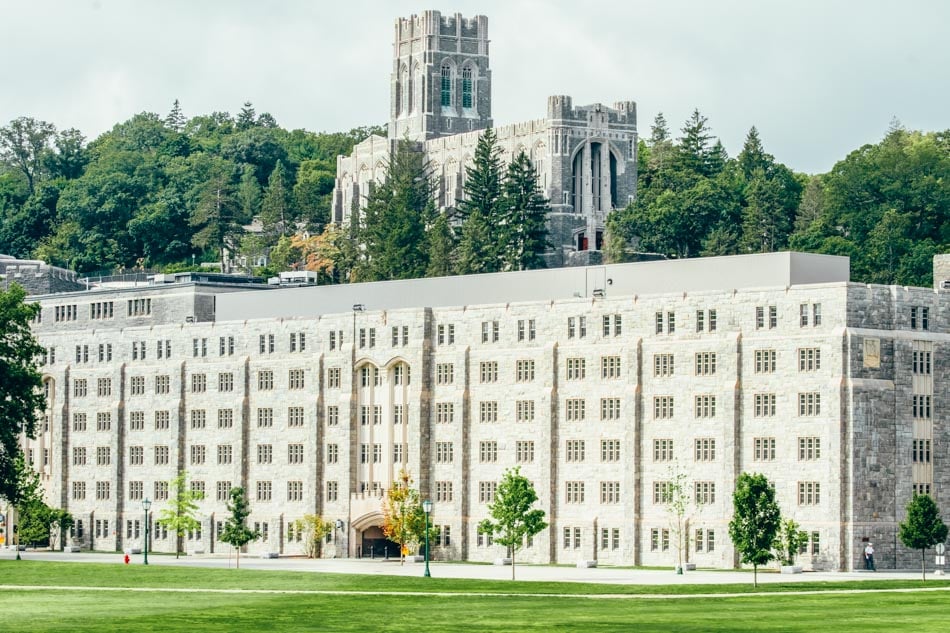
What’s the History of Hudson Valley?
The Hudson Valley was home to two tribes, the Lenape and the Mohican, for several thousand years. There were hundreds of villages in the Hudson Valley and the tribes in the area were thriving before European colonization.
When the English explorer Henry Hudson sailed up the Hudson River in 1609, he was closely followed by the duplicitous Dutch West India Company who bought land from tribe members who just thought they were renting their land. The Hudson Valley was considered the “spine” of the Dutch colony and the Dutch presence is still seen across the area in signage, names, and culture.
Around the late 1700’s and during the Revolutionary War, the Hudson Valley area was sort of the wild west of the new world, full of miscreants, military men, wealthy settlers, rivalries, and skirmishes between British Loyalists and American revolutionaries – not to mention Dutch settlers. The area was also rife with “Hessian Jagers,” German sharpshooters and expert horsemen working for the British Empire to fight the American uprising. And yes, this is where the Legend of Sleepy Hollow drew inspiration – more on that later!
Despite the chaos, or perhaps because of it, Hudson Valley was incredibly important during the Revolutionary War and the beginning of the United States of America. The Battle of Stony Point took place along the Hudson River and the first President of the brand-new U.S.A., George Washington, turned modern-day Newburgh into his headquarters for a year.
Today, you can still bear witness to the region’s military history at the United States Military Academy, West Point, built in the early 1800s. Considered one of the most strategically important places as well as the oldest continuously occupied military post in the country, the stone fortress has long stood watch over the Hudson River.

Things to Do in Hudson Valley
The Hudson Valley has seen a lot of growth and change in the past two centuries as New York City became what it is today. It’s now where New Yorkers hike, vacation, and move when they want more space than their one-bedroom in Williamsburg.
To be clear, it isn’t much cheaper than New York City anymore, but it’s a helluva lot prettier if you enjoy the outdoors! So whether you’re vacationing from the city or coming from across the country, here are some of the best things to do in the beautiful Hudson Valley.
Visit Sleepy Hollow
Yep: Washington Irving’s Sleepy Hollow exists right here in the Hudson Valley! It’s not only an actual town called Sleepy Hollow, but also the home of the author of the famous novel The Legend of Sleepy Hollow, Washington Irving. I haven’t seen any headless horsemen in the area recently, but who knows…
The town of Sleepy Hollow didn’t actually exist until 1996! The area has been occupied by European settlers since the 1600s, but it was known as North Tarrytown. I think Sleepy Hollow is a much better name, don’t you?
Today, a visit to Sleepy Hollow feels a bit like stepping into the story itself. Each October the town comes alive with Halloween decor and headless-horseman-theming (it’s even the high school mascot). You can take tours exploring myths and legends, ghosts, and more.
No matter what time of year you visit, there are intriguing secrets to uncover. The town is filled with beautiful historical homes that once belonged to the nations’s wealthiest families, which to me, can only mean one thing: rich people with dark secrets and skeletons stuffed in their unnecessarily large closets. Ooooh! I mean, Washington Irving must have been inspired by something pretty freakin’ creepy here, right??
Though some controversy surrounds whether or not the headless horseman was based on a real person, there was an account of a German Hessian soldier who lost his head to a cannonball during the Battle of White Plains around Halloween in 1776. This seems to check out, because Irving writes in the Legend of Sleep Hollow that the headless horseman was in fact, “the ghost of a Hessian trooper, whose head had been carried off by a cannon-ball in some nameless battle during the Revolutionary War.” In this case, life may be just as strange as fiction!
In addition to visiting the local landmarks that inspired the fatal story of Ichabod Crane, you can tour a few of the area’s most fabulous and famous homes:
- No visit to Sleepy Hollow is complete without a visit to Washington Irving’s romantic home, Sunnyside. The home is a unique mix of old Dutch stonework and gables, Tudor-style chimneys, Gothic windows, and a Spanish tower. Irving poured a hefty fortune into the landscaping on the Sunnyside property, which has a charming pond, stream, and small waterfall. Tours of the house are available and you’re led around by a guide in period costume – but during October, your tour will be much spookier … and include a literature-themed scavenger hunt! After visiting his home, go to his grave in Sleepy Hollow Cemetery, where you’re much more likely to see a headless horseman and/or meet a ghost. The cemetery itself is free to walk around, but you can book a guided walking tour and have all the spooky stuff (as well as a lot of history) pointed out to you.
- Don’t miss a tour of the Octagon House, which is swirled with myths and mysteries connecting the home to the spiritual world. The home is shaped like a Roman temple complete with a dome, which was apparently all the rage in the 1860’s thanks to the publication of a book, The Octagon House, A Home for All, by Orson Squire Fowler, a phrenologist, sexologist and amateur architect. What a resume! In addition to being fabulously weird, the house is also, of course, haunted AF.
- The Rockefeller Estate, Kykuit: This grand hilltop mansion was home to four generations of the Rockefeller family. The name Rockefeller is synonymous with wealth and power in this country, so it’s no surprise people flock to their lavish estates to see how this larger-than-life family lived. But with great power comes great secrets too, some of which have skeletons too big to keep hidden in the closet. To begin with, the father of John D. Rockefeller was a man named William A. Rockefeller, and he was a con artist, pretending to be a deaf / mute and selling fake miracle cures to whoever he could. The Rockefellers also had their share of mysterious deaths: 23-year-old Michael Rockefeller, son of Nelson Rockefeller, disappeared in 1961 on a trip to New Guinea to collect Primitive Art and record ethnographic data. When his boat overturned, he swam to shore seeking help, and was never seen again. A month later a priest told the expedition that a cannibal tribe said they killed a man by Michael’s description, and showed bones as proof. Touring their fabulous home may give you some clues to these mysteries, or it might leave you with more questions than answers…
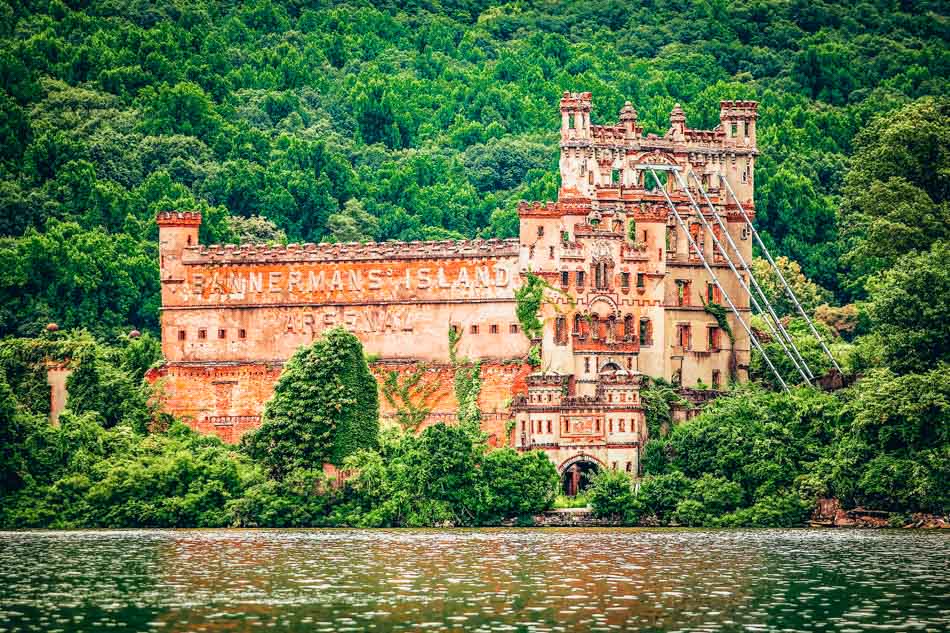
Kayak to an Abandonded “Castle”
I’ve been trying to get Michelle Obama arms for over a decade. It hasn’t happened yet, but I always feel like I’m getting a little closer to my goal every time I kayak! And what better way to spend some time on the river than trying to get to an unusual place?
I recommend combining a kayak rental with a visit to Bannerman Castle on Pollepel Island, which was built by David Bannerman in 1901. Only the facade is left of this Scottish-style castle, and though it looks majestic, it was really a storage facility for Bannerman’s ammunition business, with “Bannerman Island Arsenal” written on the side of it (castle advertisement!).
The castle barely survived devastating fires and was abandoned for a few decades. Eventually, a group of people in the surrounding community formed a trust with the New York State Office of Parks, Recreation, and Historic Preservation and decided to bring this castle back to life.
Well, maybe not back to life, but you can safely visit it now! You can’t directly enter the structure, but the tours lead you on a walk around the grounds, ruins, and through the beautifully crafted gardens where you learn about the history and restoration of the castle.
In order to get over to the island, you can book a two-hour kayak tour which takes you close to the island but not on it, or a three-hour tour which includes kayaking and a walking tour! You can also take the less intense way, a 2.5-hour tour which takes you over by boat, then provides you with a walking tour on the island.

Check out the Farm-to-Table Movement
The farm-to-table movement has kind of taken over the food discourse in recent years. That’s certainly not a bad thing – we should be eating foods grown locally and cutting down on agricultural transportation emissions, purchasing from local vendors, and eating what’s in season. Sometimes, it feels like a bit of a buzz word though and it’s unclear if people are actually adhering to what the practice means.
In the Hudson Valley, institutions like the Culinary Institute of America and working with small farms and orchards have been a part of the food scene for decades. The farm-to-table concept is widely practiced, and you can taste the difference.
The Culinary Institute of America
Right down the road from FDR’s estate is the Culinary Institute of America (CIA), one of the premier culinary institutions in the world. Normally, slightly annoying foodies like myself can not only visit the CIA and eat at a restaurant with food prepared by CIA students, but we can even take classes!
There are several restaurants on campus, and you need reservations for almost all of them. Hours change depending on when classes are in session so check the website and make sure they’re open when you want to go. You never need a reservation to visit the Apple Pie Café on campus, but the hours are also dependent on when students are on campus.
I have eaten at several of the restaurants at the CIA. Their menus can change from season to season, but one of my favorite things to order is the gnocchi at the Italian restaurant, Ristorante Caterina De’ Medici, because the gnocchi is perfectly done. It’s pillowy and light and doesn’t sit heavy in your stomach like poorly made gnocchi can.
The classes are expensive – a single-day class can cost $250, but if you’re a foodie and you want to make it one of your splurges, it’s worth it to learn from world-renowned chefs for the day.
Some of the best classes they offer are the baking classes. They’ll teach a whole class about one specific bread, pies and tarts, or even baking fundamentals. The pies and tarts course is phenomenal; you not only learn how to bake delicious crusts and fillings, but you get to eat your creations as you go, and watch a professional turn a simple baked good into a piece of art so that you can do the same thing in the future.
Blue Hill Farm at Stone Barns Center for Food & Agriculture
If you’re a Chef’s Table fan, then you know about Blue Hill Farm. In season one, we were introduced to Chef Dan Barber, who is not only considered a pioneer in the farm-to-table space, but who is working with farmers to develop unique grain types and new produce.
Barber helped turn the term farm-to-table from a buzzword into a holistic practice. He began cultivating menus based on what he and his team foraged for that day and started working directly with local farmers, paying attention to what the soil wanted to do, and not just creating a menu and shopping at the local farmer’s market.
There are two Blue Hill restaurants – one in Greenwich Village in NYC and the other in Tarrytown. As of 2021, Barber is stepping away from Chef duties in Tarrytown, and instead there will be a chef-in-residence for every season. While they don’t publish their menus ahead of time, you can be sure you are getting the freshest of the fresh farm ingredients. Blue Hill does a multiple-course tasting menu and every chef-in-residence will charge a different price, so check the website.
If you are keen on diving into the farm-to-table scene, you can visit Stone Barns and take a field trip, where you can join the farmers for a tour across rolling hills, grasslands and meadows where cattle, goats, and other animals are wandering. Across the acres of carefully curated farms and gardens, you’ll hear about regenerative agricultural techniques and how changing the way we farm can help communities suffering on the frontlines from climate change.
Bradley Farms
In the summer, Bradley Farms turns into a makeshift restaurant, with communal farm-to-table meals and wine pairings that either a chef-in-residence or even Ray Bradley, the owner of Bradley Farms, makes himself. Call ahead, as there are limited tickets and you have to pay beforehand.
Sometimes the farm-to-table movement can feel pretentious or ostracizing. That’s not so here. Bradley Farms is just off of a local rail trail, surrounded by the natural beauty of the Hudson Valley. You’ll be sitting on picnic benches with locals eating something made with love and grown on that very land. There is usually local cider, beer, and even wine on tap.
Drinking a refreshing light beer, eating a freshly grown flavorful tomato dish, and sitting on a bench on a farm is exactly what I envision when I think of this important food movement being a part of our daily lives.
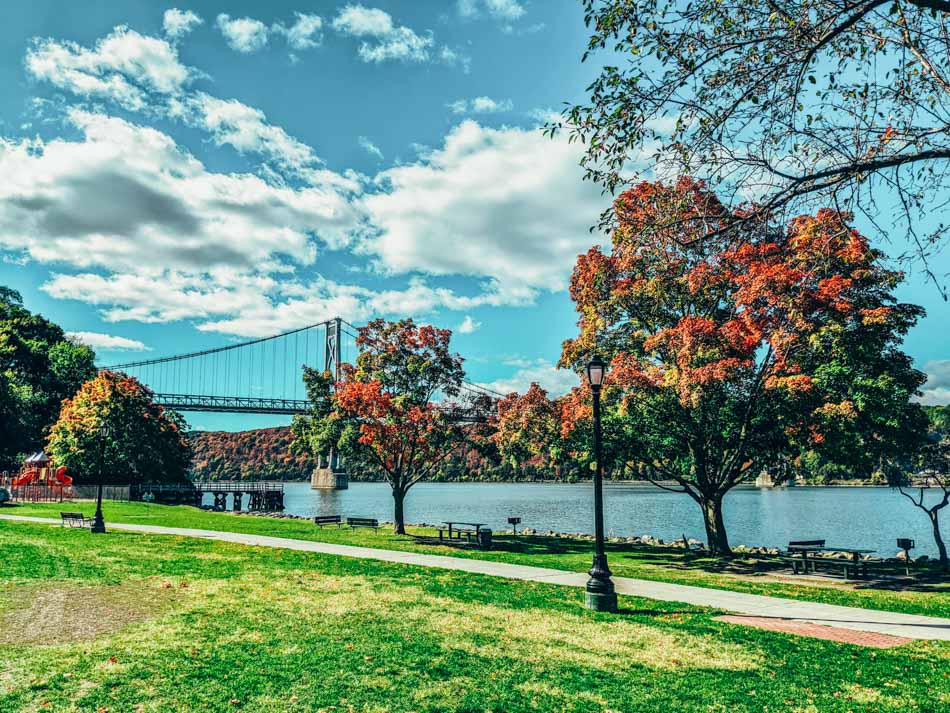
Walkway Over the Hudson
The Walkway Over the Hudson is the world’s longest elevated pedestrian bridge coming in at 1.28 miles across the Hudson River. What was once a railroad bridge, it is now a free and easy walk from the cities of Highland on the west or Poughkeepsie on the east.
As you stroll 212 feet above the glittering river, you get a clear view of the expansive body of water stretching south to north, as well as a nice shot of Hyde Park, including the Culinary Institute of America campus.
You can access the walking bridge from either side of the river. If you walk from the Highland side, there is a local ice cream shop, Frozen Caboose Ice Cream, to satiate you afterwards. On both the Highland and Poughkeepsie side, there are also food trucks during the warm weather months.
If you plan on getting on the train, you can easily walk to the Poughkeepsie train station from here. Along the walk, there are placards explaining some of the history of the bridge as a railroad.

Visit the Mohonk Mountain House
If you look up Mohonk, you’ll also come across the famous Mohonk Mountain House, a luxury resort and spa in a Victorian castle located on Mohonk Preserve. It’s a sprawling property on the edge of Mohonk Lake that makes you feel like you’ve been transported to the European countryside, perfectly perched within the surrounding forest. It’s no wonder upstate NY mountain resorts like Mohonk were popular summer destinations among upper-middle- and upper-class NYC residents in the 1950s-1960.
Though staying the night here can cost you a pretty penny (rates start at about $1000 a night), you can fully embrace your mid-century boujie summer vibe by getting a day pass to do certain activities, like a Summer Sports Pass that allows you access to all of the outdoor sports activities and facilities, like hiking, boating, tennis, etc. There’s also a Spa Pass that allows you access to the spa and the hiking trails.
Visit a Brewery or a Cider House
Fancy a crisp apple cider or a hoppy beer? You can have both in Hudson Valley! The micro-brewery scene is alive and well here, and thanks to the obscene amount of apple orchards in the area, cider houses are also having a moment. I’m certainly not complaining, and it allows us all to luxuriate in the whole casual day-drinking outside scene. Which is the vibe.
Angry Orchard
The biggest cider house in the region, and possibly the most famous as their ciders can be bought just about anywhere in the U.S., Angry Orchard helped shepherd the cider scene in a big way.
Angry Orchard has a large tasting room, a small treehouse (yes, you heard me – a treehouse!), tasting room, and outdoor space where you can get flights of cider and spend hours playing games with friends. Just keep in mind that you can’t go apple picking here, and their food menu is a bit limited.
Angry Orchard is one of the largest cider houses I’ve ever been to. It can accommodate a lot of people, which is nice if you’re a part of a large group. One of their bestsellers is the Rosé cider, which has a light floral cider flavor, perfect for nice weather and rosé wine lovers!
My personal favorite is the Stone Dry, which is Angry Orchard’s take on a more traditional English cider, because it’s more dry than sweet and has a hint of sourness. Best of all, Angry Orchard is open year-round, so you can enjoy a crisp apple cider in any season!

Twin Star Orchards
You could, and I have, spend a whole day at Twin Star Orchards. This place is a cider house, a working apple orchard and farm, and it serves food.
There is a large barn with tastings and a shop, a huge outdoor seating area with picnic tables on the edge of a lake, and orchards that you can walk through. They even provide the cider for Brooklyn Cider House in NYC.
The flavors are pretty straightforward – Raw, Kinda Dry, Half Sour, and Bone Dry. My favorite is the Kinda Dry because it’s so smooth and perfectly tart that there is no mistake about it – I am drinking apples.
You can go apple picking, do some cider taste-testing, order burgers and wood-fired pizzas, and shop for locally-sourced food and beverage products. Yummm.
Twin Star Orchards is only open from the spring through fall, so check their website before visiting to make sure they’re open.
Hudson Ale Works
Hudson Ale Works in Highland, NY is a small batch craft brewery. It’s a small space with an indoor and outdoor section, and the layout means you can watch the beer being brewed. In the warmer months, the windows are open and you can sit on stools at the open windows, but they are open year-round.
They have a Hazy Boi beer on tap with a delicious hoppy, unfiltered, fruity flavor. They also have a menu with pub staples like pretzel bites, nachos, and hot dogs.
Hudson Ale Works is a great place to end your day because it’s in an excellent location. The brewery is listed on the Empire State Trail Brewery Passport, which the New York State Brewers Association created to bring attention to the small and micro-breweries located along trails in NY. Download the New York Craft Beer App to get your passport.
As a bonus, Hudson Ale Works is located next to the Hudson Valley Rail Trail, which in turn is a part of the EVEN bigger Empire State Trail.
Yard Owl Brewery
Yard Owl Brewery is a small Belgian-inspired brewery in Gardiner and has a great vibe; it’s steps from the Wallkill Valley Rail Trail so the backyard borders forest, creating a very homey, relaxed, countryside drinking atmosphere.
It’s mostly locals here, and there are indoor and outdoor spaces to while away the afternoon. You can visit, or even take a private tour of the brewery, all year-round.
They have a rotating list of beers, including my favorite, Imperial Farmhouse, and a small food menu with a handful of things like charcuterie boards and pretzels. Imperial Farmhouse is a dark ale with just a hint of coffee so I feel like I’m tasting the story of Yard Owl and Mudd Puddle combined.

Take a Boat Tour
Yes, the Hudson River runs through the Hudson Valley! It’s fairly deep and brackish as salt water from the Atlantic Ocean and freshwater from the lakes in the Adirondack Mountains mix through a large portion of the river.
During the summer, Hudson Valley and NYC residents take to the river with all manner of boats. No fear if you, like me, don’t own a boat. (Does any non-upper-class millennial own a boat in NY? I’ve never heard of such a thing.) There are other ways, like joining a boat tour, to get out on the river!
Depending on the boat tour, there are usually food and drinks aboard — or you can bring your own. It’s a great way to spend the day outdoors and get on the water.
- My favorite boat tour is the Circle Line Oktoberfest-themed trip in the fall. I get to spend half the day on a boat surrounded by red and orange leaves, chatting with friends, eating and drinking, with more than enough room to wander around the boat deck.
- If you want to channel your inner New England Kennedy self, you can even take a sailing trip up the Hudson River. It’s a much smaller crowd and you can also purchase food and drinks aboard. I recommend some sunscreen and a lot of water as you have no cover on a sailboat like this. It’s an incredible experience if you want to feel close to the water, feel the wind in your face, and take it slow and steady on your journey.
- One of the only boat tours to begin outside of NYC is a tour with the Rip Van Winkle out of Kingston. It’s a large boat and a shorter tour, about two hours, compared to most of the boats that depart from NYC. You get to see the upper Hudson Valley, the old mansions along the rivers, and the Catskill Mountains.
Take a hike
If you’re a casual newbie hiker, the Hudson Valley is a great place to hike, as you don’t need to be prepared with anything super-specific. Hell, you don’t even need hiking shoes and can wear sneakers on most of the hikes in the valley. But you do need to be smart and considerate.
I recommend checking out the many websites dedicated to the various hikes in the Hudson Valley, including my personal favorite and often-consulted site, Hike the Hudson Valley, so you can see how difficult and how long each hike will take you.
Harriman State Park
Harriman State Park is SO close to NYC that if you just want a taste of the Hudson Valley on your NYC trip, Harriman is where it’s at. The park is the second largest state park in New York, located on the west side of the Hudson, and less than an hour outside of NYC. It could also be a great first stop if you’re about to embark on a Hudson Valley trip.
Harriman State Park has a wide array of trail options so you can go on a leisurely walk, break a light sweat, or challenge yourself on a strenuous hike.
- If you want to get a little sweaty and get a KILLER money shot of NYC (if it’s a nice day out; I can’t control the weather), I recommend Jackie Jones Mountain, a 2.8-mile out-and-back hike through shaded woods and old stone ruins.
- If you’re interested in iron-ore mines (I mean come on – who ISN’T?), there are even some abandoned mines in the area that you can find on some of the hikes listed above. Keep your eyes peeled!
Note that while certain parts of the park are free, in some spots you have to pay the car fee that’s typical at a NY state park (around $10).

Anthony’s Nose
Anthony’s Nose is a mountain peak on the eastern edge of the Hudson River, which was possibly named after a pre-Revolutionary War sea captain, or an early Dutch settler and deacon of the Dutch Reformed Church in the area, or the trumpeter on Henry Hudson’s ship.
The etymology of Anthony’s Nose is pretty much a guess at this point, but what I do know is that the peak has amazing views of Bear Mountain Bridge, which was the first vehicular bridge built to span the Hudson River between NYC and Albany.
From the top you’ll also get stunning views of the mountain opposite, Bear Mountain, which is longer and more difficult, but is a personal favorite of mine when I want an arduous hike that looks out onto the rolling hills, farms, and towns of western lower Hudson Valley.
There are two ways to hike Anthony’s Nose on the east side of the Hudson River. I recommend hiking it via the Camp Smith Trail, which takes about two to three hours on a 6-mile out-and-back trail. You get more views of the river that way!
This hike is a bit steep at times as you walk up a natural stone staircase surrounded by trees that cushion you against the sound of Route 9D below, but it’s a mostly easy hike with a couple of great lookouts onto this part of the Hudson. The view of Bear Mountain Bridge that you get at the top is definitely an iconic Hudson Valley panoramic scene.
Minnewaska State Park Preserve & Mohonk Preserve
Minnewaska State Park Preserve and Mohonk Preserve, a non-profit-run preserve, are both located on the Shawangunk Mountain Ridge, or the Gunks as locals call it. It’s a bit confusing as both Minnewaska and Mohonk are located alongside each other, but there are dozens of hiking options and 30,000 acres between the two so you can’t go wrong at either preserve.
- In Minnewaska, I recommend hiking Sam’s Point, which is a 3.3-mile out-and-back trail. It’s the mountain peak in the southernmost part of the ridge, and you access it in a slightly different spot than you do the rest of Minnewaska It’s great because it’s typically less crowded than the rest of the preserve (and on a beautiful summer day it can get CROWDED). The lookout at the top has a gorgeous view of the rest of the Gunks and the Hudson Valley — I’m talking miles of untouched natural beauty and a rare community of high altitude pitch pine barrens. You’ve never inhaled air as fresh as it is on this hike!
- In the Mohonk Preserve, there is a beautiful view you can hike to from the Skytop Tower, a memorial built at the top of the Shawangunk Ridge in the early 1900s in honor of one of the founders of Mohonk Mountain House.
- Also in the Mohonk Preserve, the Sky Top Trail is an easy 1.6-mile loop that will give you seriously stunning views from the top of the Shawangunk Ridge of the lake and Mohonk Mountain House below, not to mention views of sweeping hills and farmland for miles around.
Take a Scenic Bike Ride
One of my favorite new trails is the newly created River-to-Ridge Trail. With this trail, you can start from the heart of New Paltz, a super scenic college town nestled against the Wallkill River, and my favorite town in the Hudson Valley. New Paltz has an eclectic charm with the New Paltz University in the center of town.
While you could definitely walk this trail, the best way to traverse the 6 miles across privately owned farms and meadows is by renting a bike. The trail is fairly flat, taking you past wildflowers, cows, and through a pastoral setting that could be the subject of any Americana painting.
Keep in mind that the first few miles of the trail are free and accessible to everybody, but once you reach Duck Pond Trailhead (there will be signs), you are on Mohonk land and have to pay the fees to access Mohonk Preserve. But it’s definitely worth it if you want to pedal farther and circle a beautiful lake at the base of the Shawangunk Ridge.
Check Out a Sculpture Park
If walking around a traditional museum with loads of paintings doesn’t thrill you, but you’re still into experiencing some art, try a sculpture park. You get some steps in, spend the day outside, and soak up some culture all at once.
There are not one, but two sculpture parks in Hudson Valley:
Storm King
As far as sculpture parks go, Storm King Art Center is a pretty big deal and has been featured in shows like Netflix’s Master of None. It contains the largest-known collection of contemporary outdoor sculptures located on 500 acres of land in the western Hudson Valley.
In the mid-twentieth century, metal manufacturers Ralph “Ted” Ogden and H. Peter Stern, wanted to create a modest indoor museum housing paintings by students of the Hudson River School art movement, as well as preserve and restore the area that had recently been decimated by the New York State Thruway construction.
When the opportunity came about to acquire large steel pieces by Abstract Expressionist sculptor David Smith in 1966, Ogden took it and decided to move the project in a different direction; acquiring large-scale contemporary art that engaged with the natural beauty of Storm King that they were working to preserve. Now, there are over 100 sculptures on the grounds.
The grounds are extensive and include meadows, ponds, rolling hills, paths, and, my favorite, acres of native grasslands and wildflowers to support local pollinators like butterflies. You can be walking along one part of the grounds and feel like you can see all around you and then walk along another part and feel hidden from others.
One of my favorite pieces is the bright red Five Swords, built by Alexander Calder, with curved lines that look more like boomerangs than fighting swords. I also like the literally ginormous Three Legged Buddha, created by Zhang Huan, which showcases a Buddha’s head half-buried with three legs overhead.

Opus 40
Opus 40 is technically a sculpture park, but it’s not like Storm King Art Center or what most people picture when they think of sculptures. It’s a 6.5-acre environmental sculpture with platforms, ramps, bridges, and more built-in an abandoned bluestone quarry.
When you’re walking around Opus 40, it feels a bit like walking through a place of worship in which the deity is nature.
Harvey Fite, who died creating Opus 40, spent almost 40 years building the structure. Reportedly, Fite had been doing exactly what he loved – working on the park and mowing the lawn – when he fell into the quarry on a riding lawnmower from a 12-foot precipice.
He was self-taught and inspired by his time in Honduras helping to restore Mayan ruins, decided to use a dry keystone masonry technique and see what he could create with the bluestone in the quarry he had recently bought.
He was the only person who ever worked on the sculpture which reinforces the aura of reverence visitors feel on the property. I’m not sure there is anywhere else in the world quite like Opus 40.

Dive into Local Culture & History
As mentioned in the history section, the Hudson Valley has a LOT of history for the fledgling nation that is the United State of America. It’s also close to NYC, so wealthy people really liked buying up land and building big houses on it.
In addition to the copious amounts of historical mansions scattered throughout the area, there are also museums and other cultural sites worth visiting.
- Boscobel: Fabulous, luxurious, opulent – need we say more? This historic home tour located on the banks of the Hudson River serves up beautiful views and stunning interiors. The family who built it were Loyalists, meaning they were loyal to Britian during the Revolutionary War and even fought for the British Army, which as you can imagine wasn’t a particularly popular political stance at the time. Around the 1790’s, the family started hemorroghing money and had to blackmail some of their Loyalist associaates to stay solvent – which worked like a charm! They took all that money to build this fabulous mansion. For the rest of the story, head here!
- Franklin D. Roosevelt National Historic Site: FDR’s birthplace, home, burial place, and presidential library and museum are all conveniently located in one place at Hyde Park. FDR was the 32nd American President, won an unprecedented four times, and was President throughout much of WWII until his death. If you like presidential history, this place is a goldmine! While you need to buy tickets ahead of time to visit the main house and the library and museum, the grounds and the Rose Garden, where both Eleanor and Franklin Roosevelt are buried, are free to visit. Since this site is run by the National Park Service, an America the Beautiful Pass can get you a discounted admission.
- Dia Beacon: Contemporary art! Dia Beacon is one of 11 locations run by the Dia Art Foundation. It’s housed in a former Nabisco factory and sits on the edge of the Hudson River. Each gallery showcases a single artist’s works at a time and was designed with that in mind so you can really sink into the artist’s headspace while you’re walking around each site.
- Snyder Estate & Widow Jane Mine: The Snyder Estate Natural Cement Historic District is in Rosendale. Yes, I’m about to tell you to visit a place that’s famous for cement. I’ll explain. Cement was a big deal for a century and this area in Rosendale was home to more than a third of all cement plants in the U.S. at one point. The wings of the U.S. Capitol were built with this cement. But the best reason to visit is the Widow Jane Mine. It’s an old cement mine on the estate that has functioned as a recording studio because of the acoustics, a performance venue, and is now a big hiking destination. The lighting in the cave often has a green tinge to it, making the stone look otherworldly. Admission is only $5, and you get access to both the museum about the Rosendale Cement District (yes, CEMENT) and the mine.
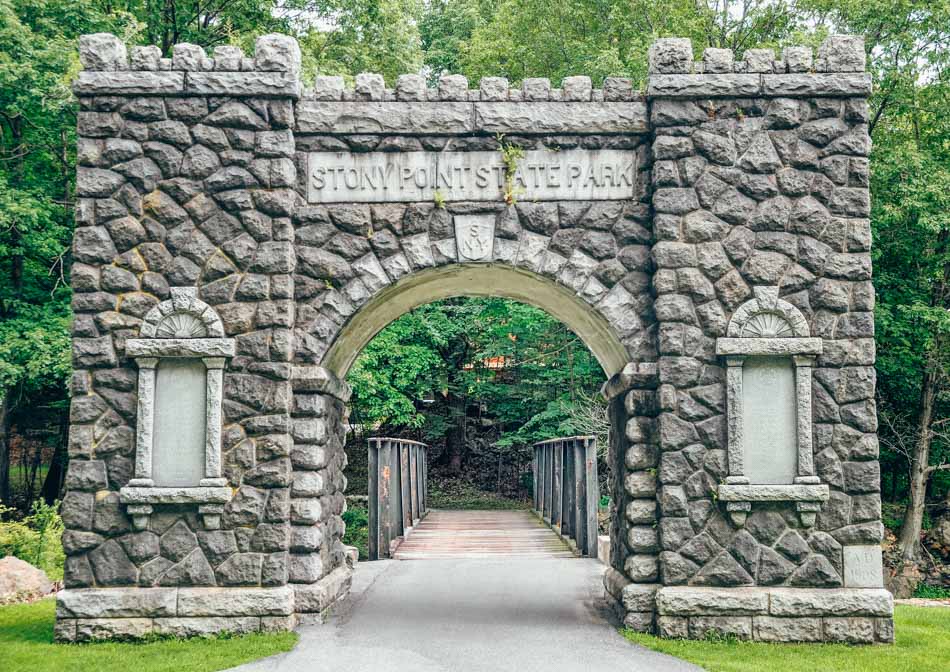
Explore the Hudson Valley’s Connection with the American Revolution
When most people think of American Revolutionary history, they often think of big southern battles like Yorktown, but the first half of the war was fought primarily in the north. New York saw its fair share of action, considering access to New York Bay and the Hudson River were vital for transportation.
- Stony Point: The battle of Stony Point was a small — but crucial — battle in the American Revolution. The American forces won the battle in July 1779, but within two days, left the British to reclaim it. Now, you can visit the Stony Point Battlefield State Historic Site and see the oldest lighthouse on the Hudson River, the Stony Point Lighthouse. It’s free to walk around the site and visit the lighthouse and small museum.
- Washington’s Headquarters State Historic Site: From April 1782 to August 1783, the future first President of the U.S. made Hasbrouck House in Newburgh his headquarters, which you can now visit as Washington’s Headquarters State Historic Site. He rejected the proposition to be King and to make the new nation a monarchy there. Now there is a museum with an exhibit containing over a thousand objects from Washington’s collection. You can take a tour, which includes access to the Tower of Victory, a recently restored belvedere with a view of Mount Beacon.
- West Point Military Academy wasn’t actually established until 1802. However, the genesis of the fortress came about during the Revolutionary War because Washington considered the spot crucial to winning the war. Now, West Point is a functioning military academy, so you can’t just enter the grounds for fun — but you can take a guided bus tour from the West Point Visitors Center. You’ll need a government-issued photo ID for admittance, and if you’re not American, you must bring your actual passport to West Point for identification.
Go to a Festival or Attend a Show
There are countless festivals and shows in the Hudson Valley. Probably helped along by the proximity to NYC, there is almost always some type of cultural event to attend.
Bethel Woods: Site of THE Woodstock Music Festival
Bethel Woods Center for the Arts in Bethel is an amphitheater and performing arts venue. It also happens to be the site of the 1969 Woodstock Festival. Seeing a performance at Bethel Woods feels euphoric – like you’re honoring music history.
You can keep an eye on upcoming performances that you might be interested in via Bethel Woods’ website or keep an eye on Ticketmaster. In addition to seeing a performance at Bethel Woods, you can check out the museum and learn about the 1969 festival that changed music.
You might get a little confused if you look up Woodstock because there is also a town called Woodstock over 50 miles away from the site of the Woodstock Music Festival. (Small sidenote: my hometown of Wallkill was supposed to be the original site of the music festival and when they backed out, Bethel took up the mantle.)
The town of Woodstock is worth a visit all of its own if you love the small picturesque Hudson Valley town atmosphere. It leans into sharing the same name as the music festival, with cute candle stores and hippie cafes — whereas the town of Bethel, where Bethel Woods Center for the Arts is located, doesn’t have a lot going on.
I love visiting Candlestock in Woodstock because everything is handmade. In the center of the store rests Drip Candle Mountain, a structure of candle wax drops that’s over six feet tall and was first created in 1969 in the original owners’ home.
Rosendale Street Festival
Rosendale Street Festival is a street music festival typically held in July which has been happening for almost 50 years. Main Street in Rosendale is shut down for two days and features seven stages with over 80 performances in two days, as well as over 100 vendors, including food and crafts.
Rosendale is not far from New Paltz and Woodstock and embraces that hippie Hudson Valley lifestyle, with craft vendors selling tie-dye items, incense, and guitars. The food vendors are primarily from local restaurants, as well as some larger sponsors. It’s locals who create, run, and continue growing this festival year after year, so there is a distinct small-town vibe where everybody seems to know each other.
You can follow their Facebook group to keep an eye out for announcements. Not only does this festival support local businesses and local artists, but the proceeds go towards supporting the music departments in several local school districts.
Gardiner Cupcake Festival
The Gardiner Cupcake Festival started less than ten years ago. The festival happens at Wrights Farm, a personal favorite farm of mine since I was a child. Wrights has a farmstand that is open year-round, and I often get their strawberry and rhubarb jam, which is filled with chunky sweet bits of berry and rhubarb that I like to slather on any and all bread.
Vendors change every year at the cupcake festival so it’s hard to predict who will be there until they post the vendors on the website. One year, there was an Italian rainbow cookie cupcake from local baker Simply SaSa that tasted JUST like an Italian cookie with perfectly moist pieces of cake and flavorful jelly.
Another year, I had a cupcake made by Wrights called “Melt-in-your-mouth Mirage”. That cupcake was like my fantasy version of a cupcake come to life; it had sugary dulce de leche, crunchy salty pretzels, and a pat of caramel frosting on top. Heaven. In. A. Cupcake.
In recent years, there has also been a 5k run through Wrights’ apple orchard beforehand, which further encourages me to eat more cupcakes than I would have otherwise. There is usually some food other than cupcakes (not sure why you would want that here though), beer tastings, cider tastings, and more.
It usually takes place in May, but confirm dates on the festival’s website or the Facebook group.
Hudson Valley Garlic Festival
I love garlic. I know it makes my hands smell like garlic for days. I know not everybody likes garlic (ABSURD I TELL YOU), but you should.
The Hudson Valley Garlic Festival was originally meant to be a one-time promotional event for a local farm in Saugerties and to bring some awareness to New York-grown garlic. Things quickly escalated after a notice was put in a local paper and hundreds of people showed up. Every year after, the festival grew in size, and it’s now held over two days in the fall. Today’s festival includes food vendors, music performances and entertainment, and cooking demonstrations.
Here you can learn about the different garlic varieties, what kind of flavor profile each has, and how to cook with them. You can purchase sauces, meal kits, meats, cheeses, and so much more than just garlic produce. I like to wander around, try as many samples as possible, and buy a few gifts and things for myself.
There is a black garlic cheese from Cooperstown Cheese Company that I actively search for at the festival. Black garlic is processed for 12 days at low temperatures so that it caramelizes. That tangy sweetness is such a unique and decadent flavor that it makes one of my favorite cheeses. I highly recommend getting some if you attend!
The Garlic Festival is hardcore. Tens of thousands of people come to the Garlic Festival. Then we all smell for a while. No biggie. Sacrifices have to be made sometimes.

Where to Stay in the Hudson Valley
Hudson Valley has a wide range of accommodations for visitors to the area. Unfortunately, prices run the gamut from moderately expensive to very expensive, unless you stay at a chain hotel. Searching for a boutique hotel that’s decently priced or a solid VRBO will be your best bet.
- This Cozy Farmstead Cottage in Stone Ridge is ideal for anyone who’s looking for a serene — and adorable — setting. This little cottage sits between two handsome barns, all of which were once part of a working farm. This is an idyllic country setting – though only minutes from a historic village, restaurants, and farm-fresh produce – with a beautiful cottage, perfect for a relaxing stay in the Hudson Valley.
- This historic-yet-modern loft is a hip spot to stay in the Hudson Valley. This loft is spacious, but it also manages to be cozy with warm exposed brick and beams. Located in downtown Kingston, this apartment is a short walk away from coffee shops, eateries, breweries, and boutiques.
- The Village Inn in Saugerties is located above a country store front, so you know it’s gonna be darn adorable. There are four rooms, and the inn has a two night minimum stay on weekends and holiday policy. Saugerties is a super cute town in itself, and extremely walkable to boot!
About Our Contributor: Leah Wersebe is a TV aficionado and a recovering 9-5 office worker. She lives in New York and has traveled to over 25 countries in search of the perfect latte. Leah has degrees in international politics, film, and wildlife conservation, and is an aspiring writer and storyteller
What are you looking forward to seeing first? Let us know in the comments below
Psst: Looking at venturing East? We have a few other posts exploring the East Coast!
Our Top Travel Tips & Resources
- Booking Flights: To score flight deals, search on Skyscanner or Kayak. Money-saving tips: fly mid-week or on the weekend; fly carry-on only on a budget airline; and take red-eyes or early morning flights.
- Accommodations: We usually stay in budget-friendly, vacation rentals, boutique hotels or private rooms in hostels. We use Booking.com to book hotels (we love their flexible cancellation policy) and Hostelworld to book hostels (low deposit, easy change/cancellation, and excellent reviews). For vacation rentals, we prefer to book using VRBO (they’ve got lower fees and better support than Airbnb, and we’re not fans of Airbnb’s unethical track record.) You can also book vacation rentals on Expedia and Hotels.com. We’ve also used TrustedHousesitters as both hosts (for our home and our fur-child) and travelers!
- Travel Insurance: We always, always, ALWAYS buy travel insurance for international trips, and we STRONGLY suggest it – visit our Travel Insurance Guide to find out why. We recommend either World Nomads or SafetyWing for international travel insurance. SafetyWing is one of the few policies that covers Covid-19, and they have excellent monthly policies that are perfect for Digital Nomads and long term travelers!
- Vaccines & Meds: We use the travel guides on the CDC website to research recommended medications and vaccines for international trips. We always recommend getting every vaccine recommended by the CDC! You can get them at your primary care doctor’s office or a walk-in pharmacy.
- Tours: We love booking guided tours, especially food tours and walking tours, to get a local’s perspective and a history lesson while sight-seeing! We book our tours using Viator and GetYourGuide.
- Transportation: We use Rome2Rio to figure out how to get from place to place using public transit, and book local transportation online using Bookaway wherever we can. When we book a rental car, we use Kayak to compare rental companies and find the best deal.
- Luggage Storage: Whenever we’re checking out early or taking advantage of a long layover, we use Stasher or LuggageHero to safely store our luggage while we’re running around. On Stasher, you can use the code PW10 for 10% off!
- What to Pack: Here are the travel essentials that we bring on every trip. We also have packing lists for hot weather, cold weather, and many more. Take a look at all of our packing guides!
There has never been a better time to plan your next trip and make your Dream vacation a reality . Whether you've been dreaming of relaxing on a sun-kissed beach, exploring ancient cities, or embarking on an epic adventure, now is the perfect moment to make it happen.


